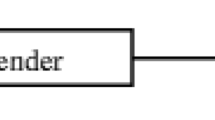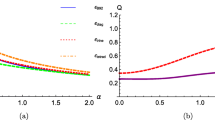Abstract
Relative entropy between two quantum states, which quantifies to what extent the quantum states can be distinguished via whatever methods allowed by quantum mechanics, is a central and fundamental quantity in quantum information theory. However, in both theoretical analysis (such as selective measurements) and practical situations (such as random experiments), one is often encountered with quantum ensembles, which are families of quantum states with certain prior probability distributions. How can we quantify the quantumness and distinguishability of quantum ensembles? In this paper, by use of a probabilistic coupling technique, we propose a notion of relative entropy between quantum ensembles, which is a natural generalization of the relative entropy between quantum states. This generalization enjoys most of the basic and important properties of the original relative entropy. As an application, we use the notion of relative entropy between quantum ensembles to define a measure for quantumness of quantum ensembles. This quantity may be useful in quantum cryptography since in certain circumstances it is desirable to encode messages in quantum ensembles which are the most quantum, thus the most sensitive to eavesdropping. By use of this measure of quantumness, we demonstrate that a set consisting of two pure states is the most quantum when the states are 45° apart.
Similar content being viewed by others
References
C. A. Fuchs, Just two nonorthogonal quantum states, arXiv:quant-ph/9810032.
C. A. Fuchs and M. Sasaki, The quantumness of a set of quantum states, arXiv:quant-ph/0302108.
D. Bruß, D. P. Divincenzo, A. Ekert, C. A. Fuchs, C. Macchiavello and J. A. Smolin, Optimal universal and state-dependent quantum cloning, Phys. Rev. A, 57 (1998), 2368–2378.
M. Horodecki, P. Horodecki, R. Horodecki and M. Piani, Quantumness of ensemble from no-broadcasting principle, arXiv:quant-ph/0506174.
A. Wehrl, General properties of entropy, Rev. Mod. Phys., 50 (1978), 221–260.
M. Ohya and D. Petz, Quantum Entropy and Its Use, Springer, Berlin, 1993.
M. A. Nielsen and I. L. Chuang, Quantum Computation and Quantum Information, Cambridge University Press, Cambridge, UK, 2000.
V. Vedral, The role of relative entropy in quantum information theory, Rev. Mod. Phys., 74 (2002), 197–234.
H. Umegaki, Conditional expectation in an operator algebra, IV. Entropy and information, Kodai Math. Sem. Rep., 14 (1962), 59–85.
S. Kullback and R. A. Leibler, On information and sufficiency, Ann. Math. Statist., 22 (1951), 79–86.
S. Kullback, Information Theory and Statistics, John Wiley and Sons, Inc., New York, 1959.
T. M. Cover and J. A. Thomas, Elements of Information Theory, John Wiley and Sons, Inc., New York, 1991.
J. von Neumann, Mathematical Foundations of Quantum Mechanics, Princeton University Press, Princeton, NJ, 1955.
G. Lindblad, Completely positive maps and entropy inequalities, Comm. Math. Phys., 40 (1975), 147–151.
A. Uhlmann, Relative entropy and the Wigner-Yanase-Dyson-Lieb concavity in an interpolation theory, Comm. Math. Phys., 54 (1977), 21–32.
M. B. Ruskai, Inequalities for quantum entropy: a review with conditions for equality, J. Math. Phys., 43 (2002), 4358–4375.
D. Petz, Monotonicity of quantum relative entropy revisited, Rev. Math. Phys., 15 (2003), 79–91.
B. Ibinson, N. Linden and A. Winter, All inequalities for the relative entropy, Comm. Math. Phys., 269 (2007), 223–238.
E. H. Lieb and M. B. Ruskai, Proof of the strong subadditivity of quantummechanical entropy, with an appendix by B. Simon, J. Math. Phys., 14 (1973), 1938–1941.
P. Hayden, R. Józsa, D. Petz and A. Winter, Structure of states which satisfy strong subadditivity of quantum entropy with equality, Comm. Math. Phys., 246 (2004), 359–374.
Z. Zhang, Uniform estimates on the Tsallis entropies, Lett. Math. Phys., 80 (2007), 171–181.
O. Oreshkov and J. Calsamiglia, Distinguishability measures between ensembles of quantum states, Phys. Rev. A, 79 (2009), 032336.
A. S. Holevo, Some estimates for the amount of information transmittable by a quantum communications channel, Prob. Peredachi Inform., 9 (1973), 3–11.
Author information
Authors and Affiliations
Corresponding author
Additional information
Communicated by Dénes Petz
Rights and permissions
About this article
Cite this article
Luo, S., Li, N. & Cao, X. Relative entropy between quantum ensembles. Period Math Hung 59, 223–237 (2009). https://doi.org/10.1007/s10998-009-0223-7
Received:
Accepted:
Published:
Issue Date:
DOI: https://doi.org/10.1007/s10998-009-0223-7




